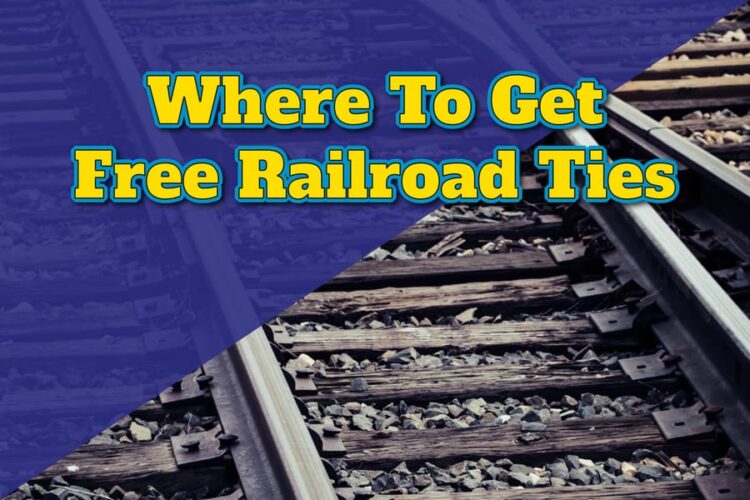Railroad ties, also known as sleepers, play a crucial role in supporting railway tracks. However, these sturdy wooden or concrete structures can find new life beyond the railroad industry. If you’re looking for free railroad ties, this article is your ultimate guide. We’ll explore the reasons for seeking free ties, their various applications, and most importantly, where to find them without breaking the bank. Discover how you can obtain these versatile materials for landscaping, gardening, and construction projects while saving costs and promoting sustainability.
Where To Get Free Railroad Ties?
You can find free railroad ties by contacting local railroad companies for unused or discarded ties, searching online classifieds and marketplaces like Craigslist or Facebook Marketplace, exploring construction and demolition sites, contacting municipal waste disposal facilities, and networking within gardening and landscaping communities for recommendations and connections.
Understanding Railroad Ties
Railroad ties, also known as railway sleepers, are essential components used to support and stabilize railway tracks. These ties serve as a foundation for the rails, ensuring proper alignment and distributing the weight of the trains. They are typically made from wood, such as oak or pine, although concrete and composite materials are also used in some cases.
The primary purpose of railroad ties is to provide a stable and durable base for the tracks, ensuring the safety and efficiency of train operations. They must withstand the heavy loads and constant vibrations generated by passing trains. The design and materials used in railroad ties are carefully chosen to endure these harsh conditions and maintain track stability over long periods.
There are various types of railroad ties available, each with its advantages and applications. Wooden ties are the most common and cost-effective option, offering strength, flexibility, and easy maintenance. Concrete ties, on the other hand, provide enhanced durability and longevity, making them suitable for high-traffic areas and heavy freight trains. Composite ties offer a combination of the benefits of wood and concrete, providing a lightweight and environmentally friendly alternative.
Proper maintenance and inspection of railroad ties are crucial to ensure their longevity and safety. Regular inspections for signs of deterioration, rot, or infestation are essential to identify and replace damaged ties promptly. Additionally, the presence of creosote-treated ties, which were commonly used in the past but are now phased out due to environmental concerns, should be considered when acquiring or reusing railroad ties.
Reasons For Seeking Free Railroad Ties
There are several compelling reasons why individuals and businesses seek free railroad ties:
- Cost Savings: Obtaining free railroad ties can significantly reduce expenses, especially for large-scale projects. Traditional sources of railroad ties may be costly, so acquiring them for free can save a substantial amount of money.
- Landscaping and Gardening Projects: Railroad ties are widely used in landscaping and gardening for various purposes. They can be repurposed as retaining walls, garden borders, raised beds, or steps. Seeking free ties allows individuals to enhance their outdoor spaces without incurring significant expenses.
- Construction and DIY Projects: Railroad ties are versatile building materials that can be used in various construction and do-it-yourself (DIY) projects. They can be employed in creating fences, benches, decks, or even furniture. Acquiring free ties enables individuals to embark on construction projects without the added financial burden of purchasing new materials.
- Environmental Benefits: Reusing railroad ties helps promote sustainability and reduces waste. By obtaining free ties, individuals can give these materials a second life instead of them ending up in landfills. It’s a way to contribute to eco-friendly practices and reduce the demand for new resources.
- Community Projects: Free railroad ties can be valuable assets for community initiatives, such as park renovations, trail development, or urban gardening projects. Acquiring them without cost allows community groups and organizations to allocate their resources to other aspects of the project and promote community engagement.
- Historical and Decorative Purposes: Railroad ties can add a unique aesthetic to outdoor spaces or be used in historical restoration projects. Seeking free ties provides an opportunity to obtain authentic and weathered materials that contribute to the desired aesthetic or historical accuracy.
Safety Concerns When Using Reclaimed Railroad Ties
When using reclaimed railroad ties, it’s important to be aware of safety concerns to ensure the well-being of individuals and the longevity of the project. Here are some key safety considerations:
- Structural Integrity: Before using reclaimed railroad ties, carefully inspect each tie for signs of damage, decay, or structural weaknesses. Look for cracks, splits, rot, or loose spikes. Ties in poor condition may compromise the stability and safety of structures or installations.
- Chemical Treatments: Some older railroad ties may have been treated with preservatives, such as creosote, to increase their durability. Creosote-treated ties pose potential health and environmental risks due to the chemicals they contain. It’s crucial to identify whether the reclaimed ties have been treated and take appropriate precautions when handling or using them.
- Handling Hazards: Railroad ties are heavy and may require special equipment or assistance for handling and moving. Improper lifting techniques or attempting to lift ties beyond your physical capacity can lead to injuries. Always use proper lifting methods, enlist help if needed, and ensure personal protective equipment, such as gloves, sturdy footwear, and eye protection.
- Splinters and Protrusions: Railroad ties, especially weathered ones, may have splinters, sharp edges, or protruding nails or spikes. Take precautions to prevent injuries by wearing gloves, using tools when necessary, and sanding down rough surfaces.
- Environmental Impact: Be mindful of the environmental impact of using reclaimed railroad ties. Avoid using ties that are excessively deteriorated or contaminated, as they can pose risks to soil, plants, and water sources. Additionally, follow proper disposal guidelines for any removed or damaged ties that cannot be safely reused.
- Code Compliance: Check local building codes, regulations, and guidelines to ensure that using reclaimed railroad ties is permitted for your intended application. Certain jurisdictions may have specific requirements or restrictions on the use of reclaimed materials.
Construction And Demolition Sites
Construction and demolition sites can be excellent sources for acquiring free railroad ties. Here are some steps to consider when exploring these sites:
- Research Local Construction and Demolition Projects: Stay informed about ongoing construction or demolition projects in your area. Keep an eye on development sites, road construction projects, or building demolitions.
- Contact Site Managers or Contractors: Reach out to the site managers or contractors involved in the construction or demolition projects. Inquire if they have any surplus or unused railroad ties that they would be willing to give away. Establish a positive rapport and explain your intended use for the ties.
- Volunteer or Collaborate: Offer to volunteer or collaborate with the construction or demolition crew in exchange for acquiring the railroad ties. Many construction projects have leftover materials that are often discarded. By volunteering your time or skills, you may be able to secure the ties for free or at a reduced cost.
- Coordinate Pickup or Delivery: Arrange a convenient pickup or delivery method for the railroad ties. Ensure that you have the necessary equipment, such as a truck or trailer, to transport the heavy and bulky ties safely. Communicate with the site managers or contractors to coordinate logistics and adhere to any site-specific safety guidelines.
- Verify the Condition of the Ties: Before finalizing the acquisition, inspect the railroad ties for signs of damage, decay, or other safety concerns. Ensure they are in suitable condition for your intended use. If you notice any issues that may compromise their structural integrity, consider finding an alternative source or request ties from another construction or demolition site.
Municipal Waste Disposal Sites
Municipal waste disposal sites can be another potential source for acquiring free railroad ties. Here’s how you can explore these sites:
- Research Local Waste Disposal Facilities: Identify the municipal waste disposal facilities in your area. These may include landfill sites, recycling centers, or waste transfer stations. Check their policies and regulations regarding the disposal and redistribution of materials.
- Contact the Waste Disposal Facility: Reach out to the waste disposal facility and inquire about the availability of railroad ties. Ask if they have any discarded or reclaimed ties that are still in usable condition. Explain your purpose and intended use for the ties.
- Understand the Policies and Procedures: Familiarize yourself with the specific policies and procedures of the waste disposal facility regarding the redistribution of materials. Some facilities may have specific rules in place for salvaging or acquiring items from their premises. Ensure that you comply with all regulations and obtain any necessary permissions or permits.
- Schedule a Visit: Arrange a visit to the waste disposal facility to inspect the railroad ties in person. Evaluate their condition, checking for any signs of deterioration, rot, or other safety concerns. It’s essential to select ties that are in reasonably good shape for your intended application.
- Coordinate Pickup or Delivery: If the waste disposal facility allows the redistribution of railroad ties, discuss and arrange the pickup or delivery logistics. Determine whether you need to provide your transportation or if they can assist in loading the ties onto your vehicle. Ensure that you have the necessary equipment and manpower to safely handle and transport the ties.
Proper Handling And Transportation
Proper handling and transportation of railroad ties are essential to ensure safety during the process. Here are some guidelines to follow:
- Use Appropriate Personal Protective Equipment (PPE): When handling railroad ties, wear protective gloves to safeguard your hands from splinters and sharp edges. Sturdy footwear should be worn to protect your feet in case of accidental drops or slips.
- Ensure Sufficient Manpower: Railroad ties can be heavy and bulky, so it’s important to have an adequate number of people to help with lifting and moving them. Enlist the assistance of others to distribute the weight and minimize the risk of strain or injuries.
- Employ Proper Lifting Techniques: Use proper lifting techniques to avoid strain on your back or other muscles. Bend your knees and lift with your legs, keeping your back straight. Avoid twisting or jerking motions while lifting the ties. If necessary, use lifting tools such as pry bars or dollies to aid in moving the ties.
- Secure Transportation Equipment: If using a vehicle for transportation, ensure it is suitable for carrying the weight and size of the railroad ties. Use appropriate tie-down straps, ropes, or chains to secure the ties to the vehicle and prevent shifting or falling during transit. Follow local regulations and guidelines for transporting oversized or heavy loads.
- Adequate Vehicle Capacity: Determine the load capacity of your vehicle and ensure it can accommodate the weight of the railroad ties without exceeding its limits. Overloading a vehicle can compromise its stability and handling, leading to accidents or damage.
Final Words
Acquiring free railroad ties can be a cost-effective and sustainable way to enhance your projects. Whether you find them through local railroad companies, online platforms, construction sites, waste disposal facilities, or community connections, prioritize safety, quality, and proper handling. Embrace the opportunity to repurpose these versatile materials while saving costs and contributing to a greener future.
FAQ’s
Are Reclaimed Railroad Ties Safe To Use?
Reclaimed railroad ties can be safe to use, but it’s essential to inspect them for signs of damage, deterioration, or hazardous treatments like creosote. Ensure the ties are structurally sound and free from any potential risks before incorporating them into your projects.
Can I Use Reclaimed Railroad Ties For Gardening Or Landscaping?
Yes, reclaimed railroad ties can be used for gardening or landscaping purposes. They can be repurposed as borders, retaining walls, raised beds, or steps. However, be cautious about potential chemical treatments or contaminants in older ties that may affect plants or soil.
How Can I Transport Heavy Railroad Ties?
Transporting heavy railroad ties requires proper equipment and secure tie-downs. Use a suitable vehicle with adequate load capacity, secure the ties tightly using straps or chains, and follow local transportation laws and guidelines for oversized or heavy loads.
Are There Any Alternatives To Using Reclaimed Railroad Ties?
If reclaimed railroad ties are not available or suitable for your needs, there are alternatives to consider. These may include using new railroad ties, alternative materials such as landscape timbers or concrete blocks, or exploring other construction materials that serve a similar purpose.
Where Can I Find Local Regulations Regarding The Use Of Railroad Ties?
Local regulations regarding the use of railroad ties can typically be found in building codes, zoning ordinances, or environmental regulations. Check with your local municipality or relevant authorities, such as building departments or environmental agencies, for information on specific regulations and guidelines in your area.







